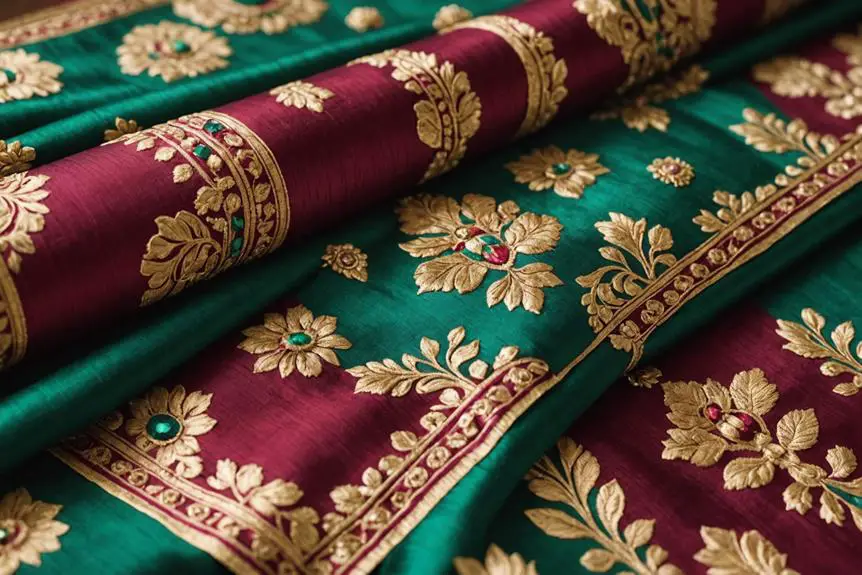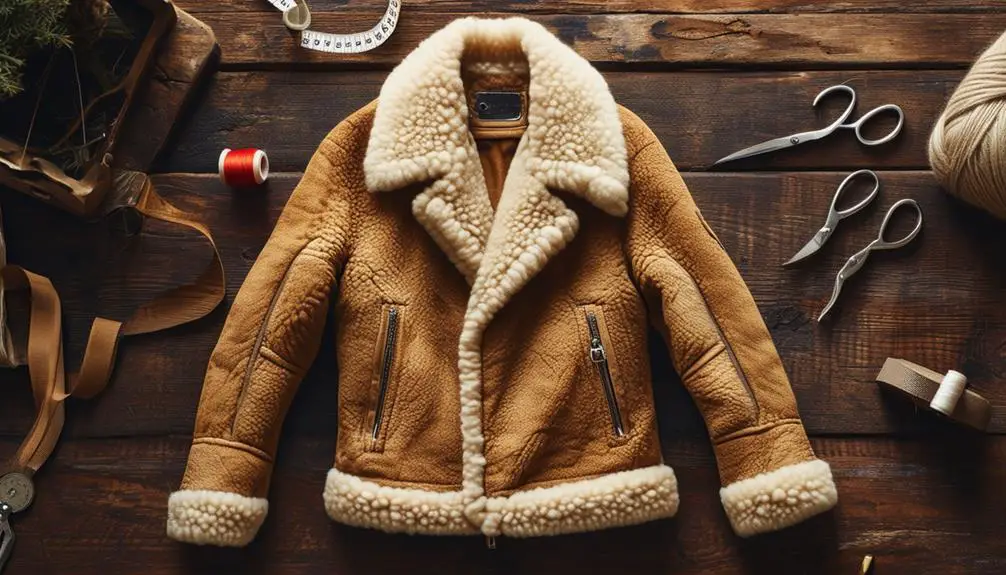When you're looking to identify genuine Banarasi silk fabric, start by checking for the Silk Mark certification, which guarantees authenticity. You'll want to examine the intricate weaving patterns, as true Banarasi silk showcases designs that are visible on both sides. Don't forget to perform a touch test; authentic silk feels luxuriously soft and has a distinct weight. Additionally, pay attention to the zari work; real zari leaves a metallic trace when rubbed. But that's just the beginning—there are more subtle details that can help you distinguish this exquisite fabric from imitations.
Unique Characteristics of Banarasi Silk
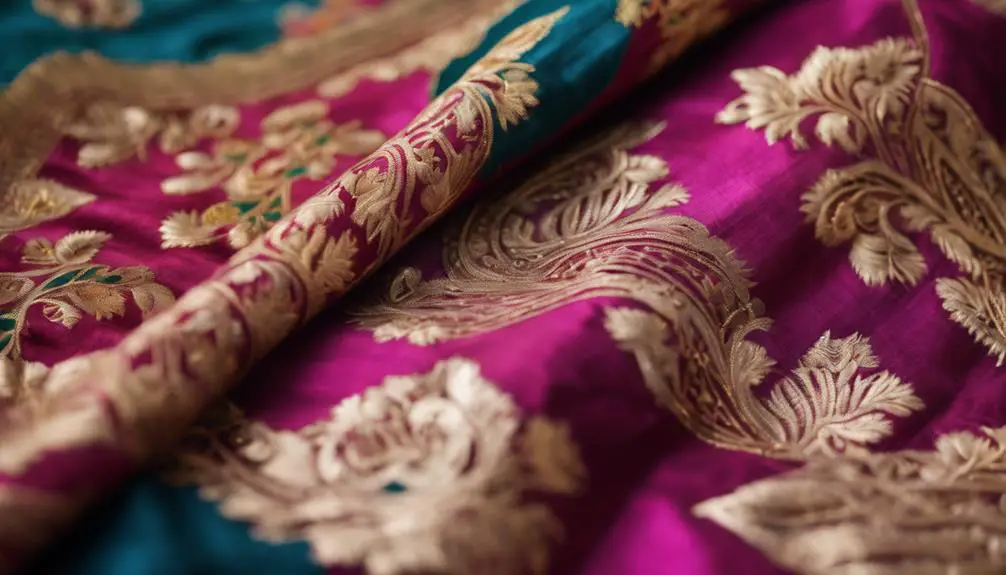
When you think of luxurious fabrics, Banarasi silk stands out with its unique characteristics that set it apart from others. This fabric hails from Varanasi, India, and it's famous for its rich sheen and soft texture. You'll love how it feels against your skin! Authentic Banarasi silk is handwoven using genuine silk threads, and it often showcases intricate designs inspired by Mughal artistry. Imagine florals and geometric patterns dancing across the fabric, telling a story of culture and history.
One of the things that make Banarasi silk special is its weighty feel. If you pick up a piece, you'll notice the addition of zari work, which incorporates gold or silver threads. This not only adds a touch of bling but also gives the fabric its substantiality. You can really see the craftsmanship involved; skilled artisans spend weeks or even months creating each piece, ensuring that the designs are visible on both sides of the saree. Isn't that amazing?
When you wear Banarasi silk, you're not just draping yourself in fabric; you're embracing a rich heritage. Each piece reflects deep cultural significance, making it a treasured textile. So, next time you're on the hunt for something truly luxurious, remember Banarasi silk. Its beauty is not just in its looks but in the artistry behind it! Why settle for less when you can flaunt such elegance?
Techniques for Authenticity Verification
To guarantee you're investing in authentic Banarasi silk, there are several techniques you can use for verification. First off, look for the Silk Mark certification. It's your golden ticket to confirming the purity and quality of the silk. You wouldn't want to end up with a faux fabric, right?
Next, examine the intricate weaving. Authentic Banarasi silk features beautiful designs visible on both sides. If you spot pin markings on the selvage, that's a good sign of handloom weaving—definitely a hallmark of genuine craftsmanship.
Now, let's talk about the touch test. When you run your fingers over the fabric, genuine Banarasi silk should feel soft and smooth. If it feels coarse or harsh, you might be holding a knockoff.
Also, pay attention to the weight of the fabric. Authentic Banarasi silk sarees are heavier than their imitations. This heft comes from the quality materials and craftsmanship involved.
Don't forget to check the zari work! Real zari is made from pure gold or silver; it should leave a metallic mark when you rub it. Synthetic zari? Not a chance!
Importance of Zari Work
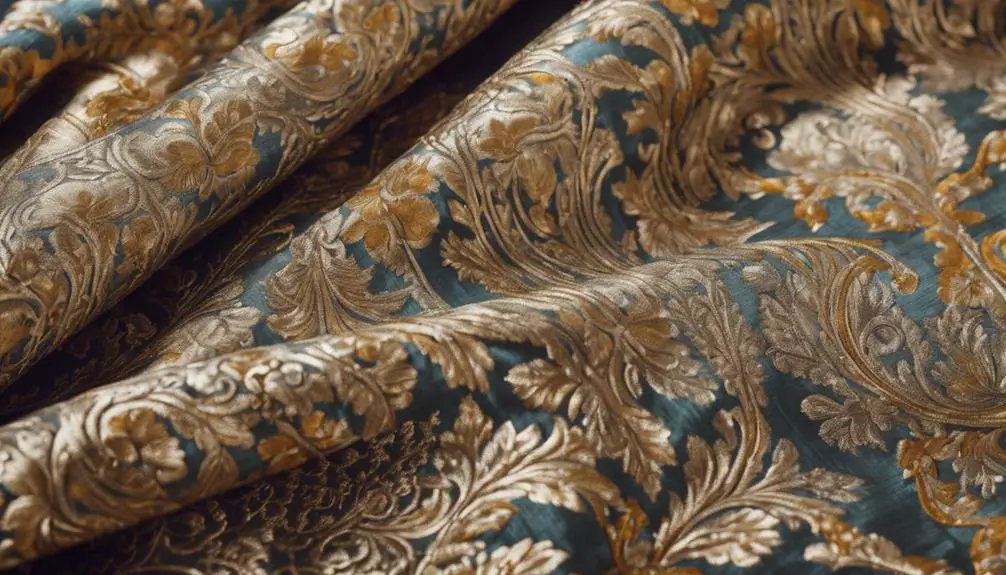
Zari work is essential to the allure of Banarasi silk fabric, as it consistently elevates the overall aesthetic with its luxurious metallic threads. When you look at authentic Banarasi sarees, you can't help but notice how the zari glimmers, thanks to the high-quality threads often made from pure gold or silver. This isn't just decoration; it's a reflection of intricate craftsmanship that has been honed over generations.
Imagine running your fingers across the fabric. The weight and texture feel so rich, right? That's the magic of authentic zari. If you rub it gently, you might even see a metallic mark, confirming its authenticity. You see, this isn't just a trend; it's a part of India's rich cultural heritage, reflecting traditional artistry that's been cherished for ages.
The elaborate motifs created with zari not only make the sarees visually stunning but also tell stories of a time-honored craft. It's like wearing a piece of history, and who wouldn't want that? Plus, the luxurious feel of pure silk combined with the opulence of zari makes every piece special.
Recognizing Traditional Patterns
The intricate patterns you see on traditional Banarasi silk fabric are fundamental to its beauty and cultural significance. When you look at a Banarasi saree, you can't help but admire its stunning Mughal-inspired designs. Think of motifs like Jaal, which resemble delicate webs, or floral Kalga patterns that bring life to the fabric. Each design tells a story, connecting you to the rich heritage of Banarasi craftsmanship.
Now, let's talk about the weaving techniques. Have you heard of butidar, jangla, and amru? These complex patterns showcase the exceptional skill of the handloom weavers. Authentic Banarasi silk is special because it features intricate designs that you can see from both sides. That's a clear sign of quality and craftsmanship—something machine-made fabrics just can't replicate.
And don't forget about the dazzling zari work! With threads made from pure gold or silver, the zari adds a regal touch to the traditional patterns. It's like a sprinkle of luxury in every saree. When you wear a genuine Banarasi saree, you're not just donning a beautiful garment; you're also embracing an artifact of artistic expression.
Tips for Online Shopping
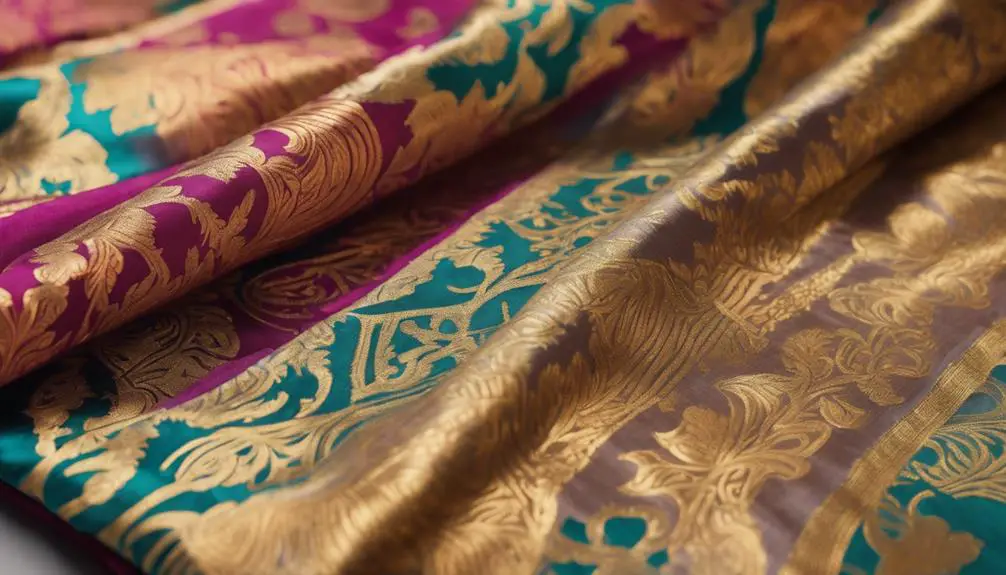
When you're shopping online for Banarasi silk sarees, it's crucial to pay attention to details that confirm authenticity. You want to make certain you're getting pure Banarasi silk sarees, right? First, check the product description. It should mention authentic zari work and high-quality silk. If it sounds too good to be true, like a bargain that's way below Rs 8,000, think twice! That could be a red flag.
Next, look for close-up images. Genuine Banarasi silk sarees boast intricate patterns and fine craftsmanship. Can you spot those beautiful details? They should jump out at you! Also, verify the saree features a plain silk patch on the pallu, along with Mughal-inspired designs. These signify true Banarasi craftsmanship.
Before hitting that "buy" button, check the seller's reputation. Look for certifications of authenticity and read customer reviews. This is where expert tips to identify genuine Banarasi silk sarees come into play. You want a seller who knows their stuff!
Lastly, don't hesitate to ask questions. If you're unsure about something, reach out! The right seller will be happy to help you. Remember, you're investing in a piece of art that tells a story of traditional weaving. Enjoy shopping online, and may you find that stunning saree that makes your heart sing!
Frequently Asked Questions
How to Identify Real Banarasi Silk?
To spot real Banarasi silk, start with a texture analysis—it's soft and smooth. Check the weight comparison; genuine silk feels heftier. Luster examination is key; it should shine beautifully. Look at color patterns and border designs—traditional weaving shows intricate details. Don't forget to reflect on thread count; higher counts mean better quality. Oh, and price evaluation helps too—if it's too cheap, it probably isn't authentic. Immerse yourself in this lovely fabric's cultural significance, and you'll appreciate it even more!
What Are the Characteristics of Banarasi Silk?
Banarasi silk's got that luxurious texture you can't resist! You'll spot its intricate weaving techniques and stunning color patterns. Plus, it's rich in historical significance and cultural symbolism—each design tells a story! When caring for it, remember to hand wash gently. You might notice some regional variations and influences from designers, which add to its charm. And hey, don't forget about fabric durability; this beauty's built to last! Isn't that awesome?
How to Identify Silk Fabric?
Wanna spot authentic silk fabric? First, check its smooth texture and soft sheen—real silk's got that luxurious feel! Try the rub test; if it clings together, it's probably fake. Don't forget the ring test! Real silk glides through easily. And hey, the burn test? If it shrinks to ash, you've got the real deal. Knowing silk's history and types helps too. Always care for your silk right, and it'll last ages!
How to Differentiate Between Banarasi and Kanjivaram Saree?
To spot the difference between Banarasi and Kanjivaram sarees, look at their origins and designs! Banarasi history is rich with Mughal motifs, while Kanjivaram's origin is all about South Indian flair. Pay attention to the weaving techniques; Banarasi is lighter, and Kanjivaram feels heavier. Check color palettes—Banarasi's often features subtle hues, while Kanjivaram's are bold. Remember, care instructions matter too! Which one catches your eye more?
Conclusion
So, there you have it! Identifying Banarasi silk isn't rocket science, but it sure does take a keen eye. Remember to check for that Silk Mark, feel that luxurious texture, and look for those stunning patterns. And when it comes to zari work, don't forget the metallic mark test—it's a real game-changer! Whether you're shopping online or in person, these tips will help you snag the real deal. Ready to flaunt your fabulous find? Happy shopping!
